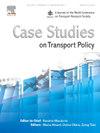Charging forward: How bus availability drives the economics of fleet electrification
IF 3.3
Q3 TRANSPORTATION
引用次数: 0
Abstract
The electrification of bus fleets is central to achieving low-carbon transport, yet uncertainties remain around whether electric buses can deliver reliable and cost-effective operations for all types of operators. While previous studies emphasise their lower fuel and maintenance costs, limited attention has been given to the economic implications of vehicle downtime. This study investigates how electric bus availability influences fleet size requirements and subsidy needs. Using detailed maintenance and downtime data from a UK bus operator, we apply a total cost of ownership (TCO) framework combined with a probabilistic model of bus availability over a 20-year period. Our analysis shows that although electric buses incur lower maintenance expenditures, their reduced availability substantially increases the number of spare vehicles required, raising capital costs – especially for smaller or rural operators. For example, electric fleet size requirements increase by roughly 18 to 23% per 10-percentage-point shortfall in availability relative to the diesel fleet benchmark. Policy simulations indicate that that if availability has not improved since 2020, then today’s operators will require procurement grants of between 35.7 and 45.0% depending on the scale of operation – and will continue to require additional financial support beyond 2040. Whereas, if availability has and continues to improve, the procurement grants required by today’s operators fall to between 30.7 and 39.7%, with no procurement grants necessary past 2032. These results highlight that vehicle availability is a critical but underappreciated factor in fleet electrification and should be explicitly incorporated into both cost analyses and subsidy design.
向前冲:公共汽车的可用性如何推动车队电气化的经济性
公交车队的电气化是实现低碳交通的核心,但电动公交车能否为所有类型的运营商提供可靠且经济高效的运营仍存在不确定性。虽然以前的研究强调它们更低的燃料和维护成本,但对车辆停机时间的经济影响的关注有限。本研究探讨电动巴士可用性如何影响车队规模需求和补贴需求。利用英国公交运营商的详细维护和停机数据,我们将总拥有成本(TCO)框架与20年期间公交可用性的概率模型相结合。我们的分析表明,尽管电动公交车的维护费用较低,但其可用性的降低大大增加了所需备用车辆的数量,从而提高了资本成本——尤其是对小型或农村运营商而言。例如,与柴油车队基准相比,每减少10个百分点,电动车队的规模需求就会增加18%至23%。政策模拟表明,如果自2020年以来可用性没有改善,那么今天的运营商将需要35.7%至45.0%的采购补助金,具体取决于运营规模,并且在2040年之后将继续需要额外的财政支持。然而,如果可用性持续改善,目前运营商所需的采购补助金将降至30.7%至39.7%之间,到2032年将不再需要采购补助金。这些结果强调,车辆可用性是车队电气化的一个关键因素,但未得到充分重视,应明确纳入成本分析和补贴设计。
本文章由计算机程序翻译,如有差异,请以英文原文为准。
求助全文
约1分钟内获得全文
求助全文

 求助内容:
求助内容: 应助结果提醒方式:
应助结果提醒方式:


